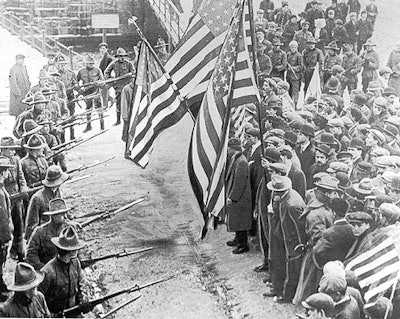
 Labor unions historically developed out of a desperate need to protect the rights of the worker. They are responsible for better wages, reasonable hours, safe working conditions, the end of child labor and even health benefits. So why do they often seem to be under so much scrutiny? Have the labor unions of today changed from the past? In an effort to evaluate the situation, I have compiled a list of some of the key advantages and disadvantages associated with union membership in today’s society.
Labor unions historically developed out of a desperate need to protect the rights of the worker. They are responsible for better wages, reasonable hours, safe working conditions, the end of child labor and even health benefits. So why do they often seem to be under so much scrutiny? Have the labor unions of today changed from the past? In an effort to evaluate the situation, I have compiled a list of some of the key advantages and disadvantages associated with union membership in today’s society.
Advantages of Unions
Unions are a source of protection for workers first and foremost. For example, unionized workers have a tendency to have higher job security than their non-unionized peers because the union makes the final decision about termination and disciplinary actions. Unionized workers also have the benefit of Union representation to advocate for them in the workplace. Unions also work to secure fair benefits and pay for their workers. Today, approximately 93 percent of unionized workers have medical benefits compared to 69 percent of their non-union counterparts.
According to CNN, if you are looking for a raise, unionizing might be your best step forward. The Bureau of Labor Statistics reports that a typical union worker made $970 a week in 2014 compared to $763 a week made by a non-union worker. That 27 percent spread isn’t just a flux, it has remained relatively constant since 2000.
Sylvia Allegretto, co-director of the Center on Wage and Employment Dynamics at the University of California, Berkeley endorsed unions and their positive impacts on wages implicitly, "You are better off in a union job because there you get to bargain for better wages."
Let’s not forget the employer either. This is a team operation and there are advantages for them in having a unionized staff. First, pay and benefits are often more steady and predictable when governed by union contracts. Also, unionized workers can be viewed as a more stable investment for training and time as they are bond by union contracts.
Disadvantages of Unions
On the other hand, there are a few serious disadvantages for unionized workers that are important to consider when evaluating unions in the workplace. The first one everyone should be aware of due to the various recent headlines: strikes. If management and union representatives cannot come to an agreement, strikes could be on the horizon. And while, non-unionized workers can go on strike, all unionized employees must strike if the majority votes in favor. This can result in serious loss of income for employees, as well as a simple loss of autonomy.
Another drawback to unionizing your labor are the dues and the fees. Fox Business reports that union dues can range from $200 to several hundred dollars per year. In some cases, these union dues and fees may offset higher wages.
Finally, union workers have often reported less collaborative work environments than non-unionized workers. As employers tend to create more separation and distance with union workers than non-union workers.
Employers also face a few significant disadvantages in regards to unions in the workplace. First, is the increased labor costs. Due to collective bargaining, employees are often able to negotiate higher wages, benefits — which can be costly.
Another employer disadvantage is that strikes obviously affect companies too. Union members are legally allowed to strike, however federal laws limit an employer’s ability to fire striking workers making them hard to navigate for employers. Strikes can then cause serious downtime and profit loses for a company.
Lastly, employers have decreased control over employees. Unions protect their own workers so it can become hard to promote, fire and manage employees around the parameters and restrictions upheld by the union.
After reviewing both the light and the dark side of unionized labor, it is clear that it isn’t perfect, but what is? It seems that unions may be a necessary check and balance integrated into the infrastructure of the workforce. But it appears that not all American’s agree feel that way, as in 2014 the percentage of workers belonging to unions declined according to federal estimates. In 1983, a little over 20 percent of workers belonged to unions compared to 11.1 percent in 2014.
What do you think?
Do you think that unions have an important place in the workplace? Other than straight-out dissolving them, what would you change about unions?
Please leave your comments below.
ENTRIES OPEN:
Establish your company as a technology leader. For 50 years, the R&D 100 Awards, widely recognized as the “Oscars of Invention,” have showcased products of technological significance. Learn more.





















